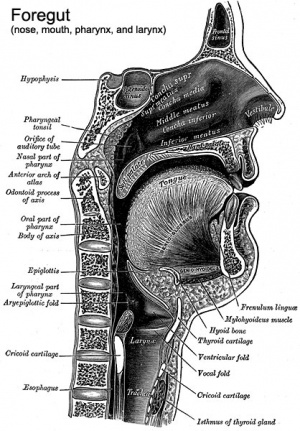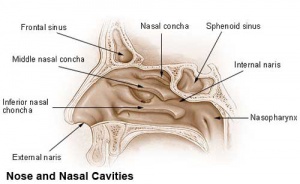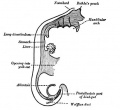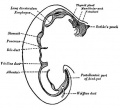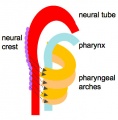Respiratory System - Upper Respiratory Tract: Difference between revisions
mNo edit summary |
mNo edit summary |
||
| Line 138: | Line 138: | ||
|- | |- | ||
| [[File:Stage13-GIT-icon.jpg|90px|link= | | [[File:Stage13-GIT-icon.jpg|90px|link=Gastrointestinal 3D stage 13 Movie]] | ||
| [[ | | [[Gastrointestinal 3D stage 13 Movie|Early embryo (stage 13)]] | ||
3 dimensional reconstruction based upon a serial reconstruction from individual [[Carnegie stage 13]] embryo slice images. | 3 dimensional reconstruction based upon a serial reconstruction from individual [[Carnegie stage 13]] embryo slice images. | ||
|- | |- | ||
| [[File:Stage22-GIT-icon.jpg|90px|link= | | [[File:Stage22-GIT-icon.jpg|90px|link=Gastrointestinal Tract 3D stage 22 Movie]] | ||
| [[ | | [[Gastrointestinal Tract 3D stage 22 Movie|Late embryo (stage 22)]] | ||
3 dimensional reconstruction based upon a serial reconstruction from individual embryo slice images [[Carnegie stage 22]], 27 mm Human embryo, approximate day 56. | 3 dimensional reconstruction based upon a serial reconstruction from individual embryo slice images [[Carnegie stage 22]], 27 mm Human embryo, approximate day 56. | ||
| Line 151: | Line 151: | ||
|} | |} | ||
:'''Links:''' [[ | :'''Links:''' [[Movies]] | ||
Revision as of 10:27, 11 March 2013
Introduction

The respiratory system does not carry out its physiological function (of gas exchange) until after birth. The respiratory tract, diaphragm and lungs do form early in embryonic development. In the head/neck region, the pharynx forms a major arched cavity within the phrayngeal arches.
The respiratory tract is divided anatomically into 2 main parts:
- upper respiratory tract - consisting of the nose, nasal cavity and the pharynx.
- lower respiratory tract - consisting of the larynx, trachea, bronchi and the lungs.
See also related notes on Smell Development and Head Development.
Some Recent Findings
References | Recent References
Textbooks
- Human Embryology Larson Chapter 9 p229-260
- The Developing Human: Clinically Oriented Embryology (6th ed.) Moore and Persaud Chapter 12 p271-302
- Before We Are Born (5th ed.) Moore and Persaud Chapter 13 p255-287
- Essentials of Human Embryology Larson Chapter 9 p123-146
- Human Embryology Fitzgerald and Fitzgerald Chapter 19,20 p119-123
- Anatomy of the Human Body 1918 Henry Gray 1. The Respiratory Apparatus
Nasal Olfactory and Respiratory Epithelium
Olfactory epithelium
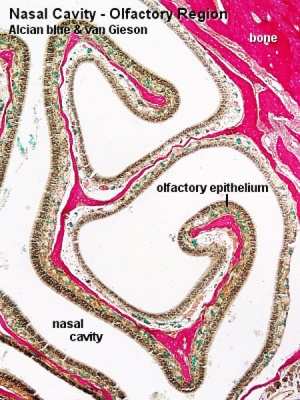
|

|
| Olfactory Epithelium (overview) | Olfactory Epithelium (detail) |
- Olfactory cells
- Sustentacular cells - located mainly in the superficial cell layer of the epithelium (difficult to distinguish from olfactory cells).
- Basal cells - identified by their location in the epithelium.
Epithelium
- Cilia are not visible
- goblet cells are absent from the olfactory epithelium.
Lamina Propria
- olfactory axon bundles (lightly stained, rounded areas) connected to olfactory cells.
- Bowman's glands - (small mucous glands, olfactory glands) function to moisturise the epithelium.
- Nasal Olfactory Histology: overview image | detail image | Smell Development | Histology | Histology Stains
Respiratory epithelium
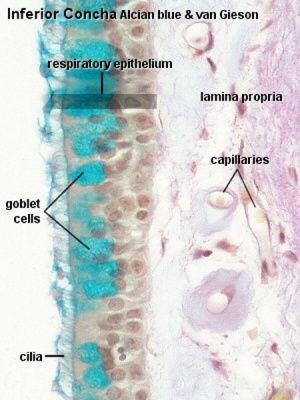
|
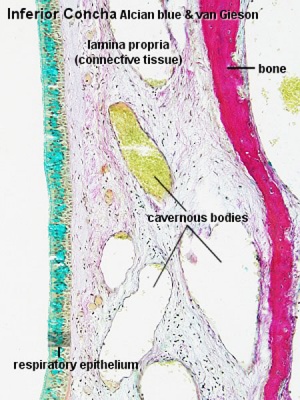
|
| Respiratory Epithelium (overview) | Respiratory Epithelium (detail) |
- goblet cells
- ciliated cells
- basal cells
Lamina propria
- connective tissue
- cavernous sinusoids - large spaces (empty or filled with red blood cells)
- glandular tissue - mucous glands (green) and muco-serous glands (brownish-green)
Bone
- Lamellae and osteocytes in lacunae.
- Haversian systems are rare or absent.
- Respiratory Histology: Bronchiole | Alveolar Duct | Alveoli | EM Alveoli septum | Alveoli Elastin | Trachea 1 | Trachea 2 | labeled lung | unlabeled lung | Respiratory Bronchiole | Lung Reticular Fibres | Nasal Inferior Concha | Nasal Respiratory Epithelium | Olfactory Region overview | Olfactory Region Epithelium | Histology Stains
Paranasal Sinuses
Paranasal sinuses are thought to develop as "pneumatisation" of bone and out-pocketing of the respiratory nasal epithelium. There are 4 paired sinuses, named by their anatomical location, and lined with respiratory epithelium. The sinuses begins to form at 10 weeks (GA) by primary pneumatisation, later in fetal development secondary pneumatisation occurs enlarging the existing spaces. These sinuses continue to enlarge postnatally.
Note that during development, these are amniotic fluid fluid-filled spaces, therefore pneumatisation (USA, pneumatization) is a misnomer as only postnatally fluid loss forms the air-filled (pneumatic) spaces.
A study of fetal cleft lip and palate[1] showed that sphenoid sinus was still present with variability in morphology compared to normal fetus perhaps due to altered shape and size of the adjacent hypertrophic cartilaginous structures.
Computed tomography measurements from a study of 120 adult (age 18-65 years) maxillary and frontal sinuses.[2]
- mean maxillary sinus volume 15.7±5.3 cm3
- larger in males than in females.
- no correlation between the volume of maxillary sinuses with either age or side.
- mean bone thickness at the canine fossa was 1.1±0.4 mm.
Frontal Sinus
Ethmoid Sinus
A 1997 article[3] based upon study of coronal sections of the heads of 23 human fetuses from 18-mm CR length to 282-mm CR length. The study suggests that the ethmoid sinus forms by: "constriction of the nasal cavity by a pair of turbinal cushions, and evagination from the nasal cavity by proliferation and subsequent disintegration of the nasal epithelium".
Sphenoid Sinus
Data quoted in a 1996 article[4] on the sphenoid sinus.
- 4 month - sphenoid sinuses can be identified.
- at birth - sinus remains small and is little more than an evagination of the sphenoethmoid recess.
- year 3 - invasion of the sphenoid bone is more rapid
- year 7 - sinus has extended posteriorly to the level of the sella turcica.
- year 12 - sphenoid pneumatization reaches its final form and a size equivalent to the adult
- adult - further enlargement into the basisphenoid may occur.
Maxillary Sinus
Developmentally, the maxillary sinus originates in the middle meatus and extends into the ethmoid cartilage.
The data below is from a recent microscopical study of 100 human fetuses from the 9th to the 37th week (GA).[5]
- week 10 - maxillary sinus begins development.
- week 37 - the anterior-posterior diameter has a mean of 4.36 mm; ossification of the medial wall was absent, and the floor was located below the attachment of the inferior turbinate. Septa and recesses were temporarily observed.
- maxillary sinus osmium (opening) was located at the anterior third of the ethmoid infundibulum
- final dimensions were 1.96 mm in length and 0.44 mm in width.
- mean length between the ostium to the lamina papyracea and nasolacrimal duct was 1 mm.
Movies
The animations below allow a comparison of early and late embryonic lung development. Compare the size and relative position of the respiratory structures and their anatomical relationship to the developing gastrointestinal tract.
| Early embryo (stage 13)
3 dimensional reconstruction based upon a serial reconstruction from individual Carnegie stage 13 embryo slice images. | |
| Late embryo (stage 22)
3 dimensional reconstruction based upon a serial reconstruction from individual embryo slice images Carnegie stage 22, 27 mm Human embryo, approximate day 56. |
- Links: Movies
References
Reviews
<pubmed>21944636</pubmed> <pubmed>16798587</pubmed> <pubmed>15222948</pubmed>
Articles
<pubmed>21147652</pubmed> <pubmed>20966466</pubmed> <pubmed>20490493</pubmed>
Search PubMed
Search Pubmed: Upper Respiratory Tract Development | Upper Respiratory Tract Embryology
Terms
Additional Images
- part of foregut development
- anatomically the nose, nasal cavity and the pharynx
- the pharynx forms a major arched cavity within the pharyngeal arches
- Larynx Image Links: All cartilages of the larynx | Epiglottis cartilage | Thyroid cartilage | Cricoid cartilage | Arytenoid cartilage | Larynx ligaments anterior | Larynx ligaments posterior | Larynx sagittal section | Larynx and upper trachea | Larynx entrance | Larynx interior | Larynx muscular attachments | Larynx muscles 1 | Larynx muscles 2 | Larynx muscles 3 | Cartilage Development | Respiratory System Development
Glossary Links
- Glossary: A | B | C | D | E | F | G | H | I | J | K | L | M | N | O | P | Q | R | S | T | U | V | W | X | Y | Z | Numbers | Symbols | Term Link
Cite this page: Hill, M.A. (2024, April 16) Embryology Respiratory System - Upper Respiratory Tract. Retrieved from https://embryology.med.unsw.edu.au/embryology/index.php/Respiratory_System_-_Upper_Respiratory_Tract
- © Dr Mark Hill 2024, UNSW Embryology ISBN: 978 0 7334 2609 4 - UNSW CRICOS Provider Code No. 00098G

